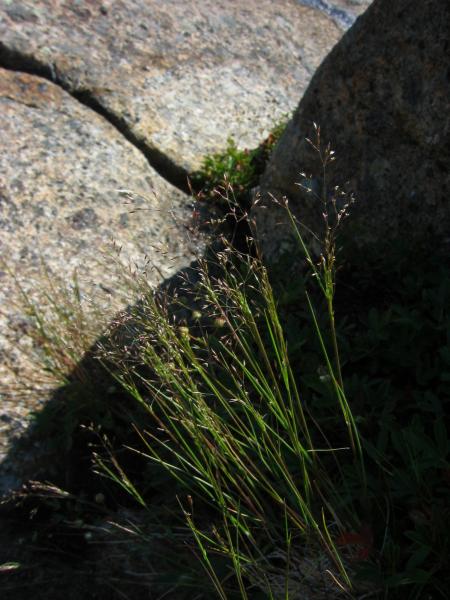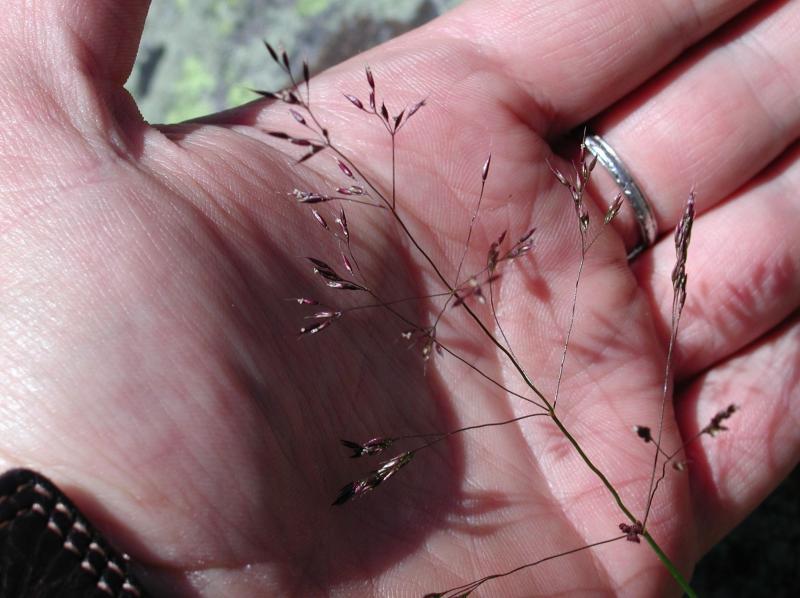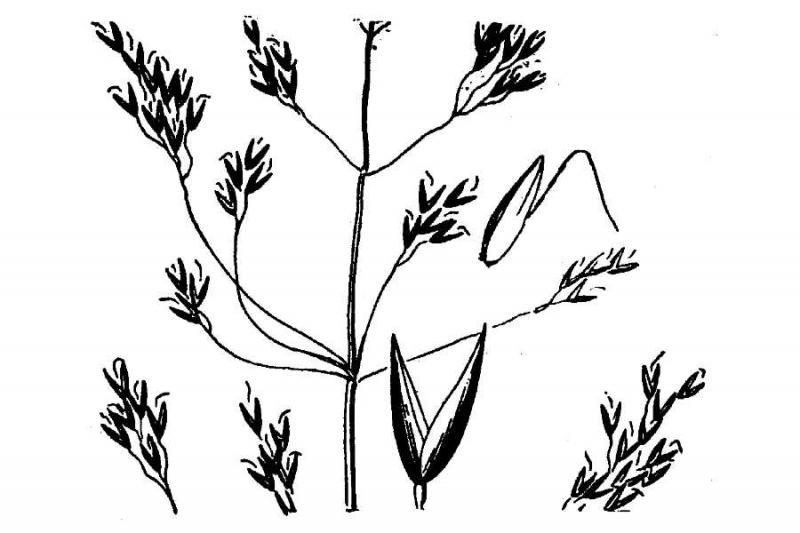Northern Bent
Agrostis mertensii Trin.
- Class
- Monocotyledoneae (Monocots)
- Family
- Poaceae (Grass Family)
- State Protection
- Threatened
Listed as Threatened by New York State: likely to become Endangered in the foreseeable future. For animals, taking, importation, transportation, or possession is prohibited, except under license or permit. For plants, removal or damage without the consent of the landowner is prohibited.
- Federal Protection
- Not Listed
- State Conservation Status Rank
- S2
Imperiled in New York - Very vulnerable to disappearing from New York due to rarity or other factors; typically 6 to 20 populations or locations in New York, very few individuals, very restricted range, few remaining acres (or miles of stream), and/or steep declines.
- Global Conservation Status Rank
- G5
Secure globally - Common in the world; widespread and abundant (but may be rare in some parts of its range).
Summary
Did you know?
The specific name mertensii was given to this species in honor of the botanist Franz Carl Mertens (1764-1831), five years after his death.
State Ranking Justification
There are 10 known extant populations. There are also three historical populations which have not been seen since at least 1961. One of these historical populations was searched for without success but further survey work is needed at this and the other historical populations before their status can be accurately determined. All of the populations occur in very limited alpine habitat on the higher mountains of the high peaks region of the Adirondacks.
Short-term Trends
Four of the ten known extant populations were first seen in the last 20 years. It is likely these populations were overlooked and do not represent new populations. Trampling, which threatens many of the populations, may have led to at least a small decline in some populations' sizes but clear data are not available. Overall, short-term trends are unclear.
Long-term Trends
Three populations have not been seen since at least 1961. One of these populations was searched for without success but further survey work is needed to determine if this and the other two historical populations have become extirpated. At least five populations are quite large, with thousands of individuals. Long-term trends are unclear.
Conservation and Management
Threats
Many of the populations are threatened by trampling from hiker traffic. One population is potentially threatened by non-native species.
Conservation Strategies and Management Practices
The Summit Steward program, which works to inform hikers of the fragile nature of alpine plants is a critical program which is helping to reduce trampling of alpine vegetation. This program and other efforts designed to reduce trampling of alpine meadows are needed. At least at one site, non-native plants should be controlled where they are growing with the northern bentgrass.
Research Needs
The three historical populations need to be surveyed. A few extant populations need further survey work as well, to better assess their condition.
Habitat
Habitat
In New York, this species is restricted to the alpine areas of some of the highest mountains in the Adirondacks. In this area it occurs predominately in open often rocky alpine meadows as well as in openings in krummholz. Sometimes it occurs on rock ledges (New York Natural Heritage Program 2007). Banks and gravel bars in river and lake valleys, and on open grasslands and rocky slopes of mountains and cliffs (Harvey 2007). Rocky soil, moist, peaty areas (Haines and Vining 1998). Peaty or rocky soil (Gleason and Cronquist 1991). Gravelly or rocky open soil (Fernald 1970).
Associated Ecological Communities
- Open alpine community
(guide)
An open community consisting of a mosaic of sedge/dwarf shrub meadows, dwarf heath shrublands, small boggy depressions, and exposed bedrock covered with lichens and mosses. The open alpine community occurs above timberline (about 4,900 ft or 1,620 m) on the higher mountain summits and exposed ledges of the Adirondacks. The flora includes arctic-alpine species that are restricted (in New York) to these areas, as well as boreal species that occur in forests and bogs at lower elevations. The soils are thin and organic, primarily composed of peat derived from peat mosses (Sphagnum spp.) or black muck. The soils are often saturated because they can be recharged by atmospheric moisture.
Associated Species
- Betula glandulosa (alpine birch, resin birch)
- Carex bigelowii
- Empetrum eamesii ssp. atropurpureum
- Empetrum nigrum ssp. hermaphroditum
- Huperzia appressa (mountain firmoss)
- Minuartia groenlandica
- Prenanthes boottii
- Salix uva-ursi (bearberry willow)
- Solidago leiocarpa (Cutler's alpine goldenrod)
- Vaccinium boreale (northern lowbush blueberry)
- Vaccinium uliginosum (bog bilberry)
- Viburnum edule (mooseberry, squashberry)
Range
New York State Distribution
In New York, this species is restricted to some of the higher mountains in the high peaks region of the Adirondacks.
Global Distribution
This species is circumboreal, occurring in Europe, Asia, and North America, including mountainous regions in Mexico. It is also apparently known from northwest South America. In North America, it occurs from Alaska east to Greenland, south in the western mountains to Wyoming and Colorado, and in the eastern mountains to northern New England and New York, West Virginia, Tenessee, and North Carolina (Weakley 2006, Harvey 2007).
Identification Comments
General Description
Northern bentgrass is a tufted perennial grass which growsfrom 10 to 50 cm tall. The leaves are 1 to 3 mm wide and usually rolled inward at the edges, and mostly crowded together at the base of the plants and along the stems. The stems are topped by an open, branching, array of small flowers (inflorescence). These inflorescences are 5 to 15 cm long, and nearly as wide at the base when fully open. As with all grasses, the small, inconspicuous flowers occur in scaley structures called spikelets. In this species the spikelets are purplish and 2-4mm long. One of the scales (the lemma) has a slender tip (an awn) which is bent at the base and about 3mm long (Harvey 2007, Gleason and Cronquist 1991).
Identifying Characteristics
Agrostis mertensii is cespitose. The culms have 2-4 nodes below the inflorescenes. The leaves have smooth or scabrous sheaths, ligules 0.7-3.3 mm long, and the 0.5-3 mm wide blades are flat or occasionally involute or folded. The panicle is ovate to lanceolate, usually open, longer than wide, and (2-)3-10 cm long. The branches of the panicles are smooth to sparsely scabridulous and bear spikelets in the distal half. The one flowered spikelets are up to 4 mm long and are on pedicles 0.4-6.4 mm long. The glumes are longer than the lemmas and the lemmas bear geniculate, persistent awns (2-)3-4.4 mm long from just below the middle. The anthers are 0.5-0.8 mm long (Harvey 2007).
Best Life Stage for Proper Identification
The best time to identify this species is when it is flowering or fruiting but the lemmas have not started to disarticulate.
Similar Species
Agrostis mertensii is superficially similar to a few other Agrostis species but its awned lemmas help to distinguish it from most of these.
Agrostis scabra sometimes has awned lemmas. These awned forms can be distinguished from A. mertensii by the panicle being quite wide (often nearly as wide as long) and long [(4-)8-25(-50) cm long], awns shorter (0.2-3 mm long), shorter spikelets (to 3.4 mm long), only 1-3 culm nodes, leaves narrower (1-2 mm wide), and panicle branches scabrous.
Agrostis canina occurs primarily at lower elevations where A. mertensii does not occur, but it also has awned lemmas. It can be distinguished by its shorter spikelets (to 3.0 mm long), scabrous panicle branches, and larger anthers (1.0-1.5 mm long).
Best Time to See
This species starts to flower in late June and the fruits persist into September, but toward the end of this season they are starting to disarticulate. Therefore, the best time to survey for this species is in July or August.
- Flowering
- Fruiting
The time of year you would expect to find Northern Bent flowering and fruiting in New York.
Northern Bent Images
Taxonomy
Northern Bent
Agrostis mertensii Trin.
- Kingdom Plantae
- Phylum Anthophyta
- Class Monocotyledoneae
(Monocots)
- Order Cyperales
- Family Poaceae (Grass Family)
- Order Cyperales
- Class Monocotyledoneae
(Monocots)
- Phylum Anthophyta
Additional Common Names
- Northern Bentgrass
Synonyms
- Agrostis borealis Hartman
- Agrostis borealis var. americana (Scribn.) Fern. [Not known from New York]
Comments on the Classification
Agrostis mertensii Trin. was long known as A. borealis Hartm. (Hitchcock and Chase 1950, Gleason and Cronquist 1963, Fernald 1970) but Trinius's name predates Hartman's by two years. Fernald (1933) recognized three varieties in A. borealis (var. borealis, var. americana, and var. paludosa). Only var. borealis was considered to be in New York. In his discussion on these varieties he mentions that "their characters are intergradient and that they have no fundamental morphological distinctions." Recent authors (Gleason and Cronquist 1991, Haines and Vining 1998, Weakley 2006, Harvey 2007) have placed these varieties in synonymy.
Additional Resources
Best Identification Reference
Harvey, M.J. 2007. Agrostis L. Pages 633-662 in Flora of North America Editorial Committee (Editors), Flora of North America, north of Mexico, Volume 24, Magnoliophyta: Commelinidae (in part): Poaceae, part 1. Oxford University Press, New York, NY, USA. 911pp + xxviii.
Other References
Fernald, M.L. 1933. Recent discoveries in the Newfoundland flora. Rhodora 35: 203-223.
Fernald, M.L. 1950. Gray's manual of botany. 8th edition. D. Van Nostrand, New York. 1632 pp.
Flora of North America Editorial Committee. 1997. Flora of North America north of Mexico. Vol. 3. Magnoliophyta: Magnoliidae and Hamamelidae. Oxford Univ. Press, New York. xxiii + 590 pp.
Gleason, Henry A. and A. Cronquist. 1991. Manual of Vascular Plants of Northeastern United States and Adjacent Canada. The New York Botanical Garden, Bronx, New York. 910 pp.
Haines, A. and T.F. Vining. 1998. Flora of Maine, A Manual for Identification of Native and Naturalized Vascular Plants of Maine. V.F.Thomas Co., Bar Harbor, Maine.
Hitchcock, A. S. and A. Chase. 1950. Manual of the grasses of the United States, second edition. USDA miscellaneous Publication No. 200. United States Government Printing Office, Washington. 1051 pp.
Holmgren, Noel. 1998. The Illustrated Companion to Gleason and Cronquist's Manual. Illustrations of the Vascular Plants of Northeastern United States and Adjacent Canada. The New York Botanical Garden, Bronx, New York.
Mitchell, Richard S. and Gordon C. Tucker. 1997. Revised Checklist of New York State Plants. Contributions to a Flora of New York State. Checklist IV. Bulletin No. 490. New York State Museum. Albany, NY. 400 pp.
New York Natural Heritage Program. 2010. Biotics database. New York Natural Heritage Program. New York State Department of Environmental Conservation. Albany, NY.
New York Natural Heritage Program. 2024. New York Natural Heritage Program Databases. Albany, NY.
Reschke, Carol. 1990. Ecological communities of New York State. New York Natural Heritage Program, New York State Department of Environmental Conservation. Latham, NY. 96 pp. plus xi.
Weakley, A.S. 2006. Flora of the Carolinas, Virginia, and Georgia. Working draft of January 17, 2006. University of North Carolina, Chapel Hill, NC. 1026pp. Currently published by the author and available on the web at (http://www.herbarium.unc.edu/flora.htm).
Weldy, T. and D. Werier. 2010. New York flora atlas. [S.M. Landry, K.N. Campbell, and L.D. Mabe (original application development), Florida Center for Community Design and Research http://www.fccdr.usf.edu/. University of South Florida http://www.usf.edu/]. New York Flora Association http://newyork.plantatlas.usf.edu/, Albany, New York
Links
About This Guide
Information for this guide was last updated on: January 31, 2008
Please cite this page as:
New York Natural Heritage Program. 2024.
Online Conservation Guide for
Agrostis mertensii.
Available from: https://guides.nynhp.org/northern-bentgrass/.
Accessed July 26, 2024.


